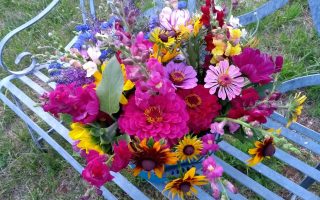Gardening in the Quercy Part 2
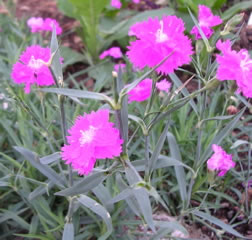
What will grow, and what won’t?
Flowers
In deciding what flowers to grow, we chose varieties that we read would thrive in the hot, dry and sunny conditions we were told to expect (resiste a la secheresse) and to brighten up le cimitiere at the front of the house (which by now had, had a top layer of breezeblocks removed and a path broken across the middle making four open and airy flower beds). So we bought perennials like Veronique Teucrium (Veronicas), ‘Johnson’s Blue’ geraniums and nepeta (catmint) ‘Six Hills Giant’ and raised annual seeds such as tournesol (sunflowers), tabac d’ornement (nicotiana) and pois de senteur (sweet peas).
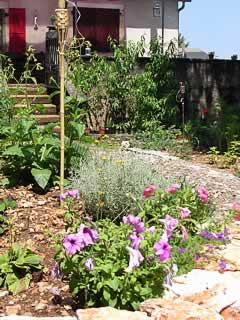 We noticed that the flowers and shrubs don’t seem to grow as large or as quickly in their first season as we remembered them doing in wet Wales where we lived previously! Plants such as Verbena Bonariensis, which we planted as an architectural feature at the back of the beds because they can reach two or two and a half metres in height, have only reached about half that height here. Cranesbill geraniums that in our previous garden were rampant in their first year, have stayed quite small plants although we planted them deliberately to be invasive and cover up the grey walls of le cimitiere! It is probably a case of bearing the different conditions in mind when planning a garden and having a bit of patience to let the plants get established….and watering, watering, watering!
We noticed that the flowers and shrubs don’t seem to grow as large or as quickly in their first season as we remembered them doing in wet Wales where we lived previously! Plants such as Verbena Bonariensis, which we planted as an architectural feature at the back of the beds because they can reach two or two and a half metres in height, have only reached about half that height here. Cranesbill geraniums that in our previous garden were rampant in their first year, have stayed quite small plants although we planted them deliberately to be invasive and cover up the grey walls of le cimitiere! It is probably a case of bearing the different conditions in mind when planning a garden and having a bit of patience to let the plants get established….and watering, watering, watering!
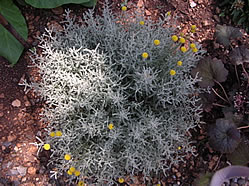 Three plants we would highly recommend because they have just continued to grow and flower through drought, heat and storm and to look completely at home here:
Three plants we would highly recommend because they have just continued to grow and flower through drought, heat and storm and to look completely at home here:
· Nepeta Six Hills Giant (Nepeta)
· Pinks (Oeillets Mignardises)
· Santolina (Santoline)
Vegetables
We chose a wide range of vegetable seeds to try out as we wanted to see what grew well in the first year and what didn’t. Then we could review successes and failures at the end of the season and plan accordingly for the following year.
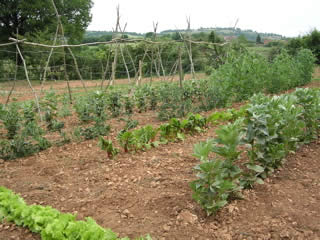
We found that peas (pois), mangetout (pois mangetout), broad beans (feves) and haricot beans (haricots) have produced excellent crops both from seeds sown straight into the ground and from small plants raised initially in the poly tunnel then planted out. Onions too, grown from sets and seeds have done very well. Courgettes, of course, are in full production as will be tomatoes, peppers and chilli peppers which are threatening to yield a bumper crop!
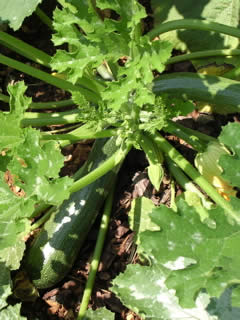 Unfortunately, not everything has grown well on the vegetable front and we have had a major disappointment with the brassicas (cauliflower, cabbage, sprouts, broccoli). Although the seed germinated quickly and they became strong plantlings, once planted out into well prepared soil they seemed to wither, developing pale patches and becoming scorched looking. We have asked advice of both French and English friends and neighbours and received the following explanations:
Unfortunately, not everything has grown well on the vegetable front and we have had a major disappointment with the brassicas (cauliflower, cabbage, sprouts, broccoli). Although the seed germinated quickly and they became strong plantlings, once planted out into well prepared soil they seemed to wither, developing pale patches and becoming scorched looking. We have asked advice of both French and English friends and neighbours and received the following explanations:
- It’s too hot and too far south. Brassicas do better in the North of France where the climate is cooler and wetter.
- It’s too early in the season (March/April). Try planting them in late August or early September when they will benefit from cooler temperatures and autumn rain.
- They’ve been eaten by ‘gendarmes’. (No, not the uniformed variety but the small beetles with decorative red and black markings that are everywhere!)
- Try ‘companion planting’ i.e. planting sage, rosemary, thyme, onions, garlic, beet and chards in between the rows of brassicas.Any helpful advice and tips on how to successfully grow brassicas in this area of the Lot would be welcomed as we would love to grow rather than buy our winter veg!
As we move into July, our main challenge now is, as we anticipated, to keep down the weeds on the plot. They spring up overnight and after a storm there is no stopping them. They have completely covered some of the stone paths and craftily hide under the larger leaves of courgettes, pumpkins etc and grow large! However, the compensations are the joy of being able to pick fresh vegetables and herbs straight from the garden and the satisfaction of having created an attractive flower garden from what was quite a gloomy space.
Read Part 1 of this article – The clearing of the land and preparation for planting.
© Lindsay Nixon 2005
Lindsay Nixon and David Low spend their time renovating a barn, running their ironwork and garden creation/maintenance business and creating a productive and attractive garden at their house in Blars.
For more information on Ironwood Motif visit David and Lindsay’s website www.ironwoodmotif.com, email them info@ironwoodmotif.com or telephone on +33 (0)5 65 30 53 99.
<!–
if (!document.phpAds_used) document.phpAds_used = ‘,’;
phpAds_random = new String (Math.random()); phpAds_random = phpAds_random.substring(2,11);
Share to: Facebook Twitter LinkedIn Email
More in businesses, courses, garden, heating, land, quercy, romance
Leave a reply
Your email address will not be published. Required fields are marked *


